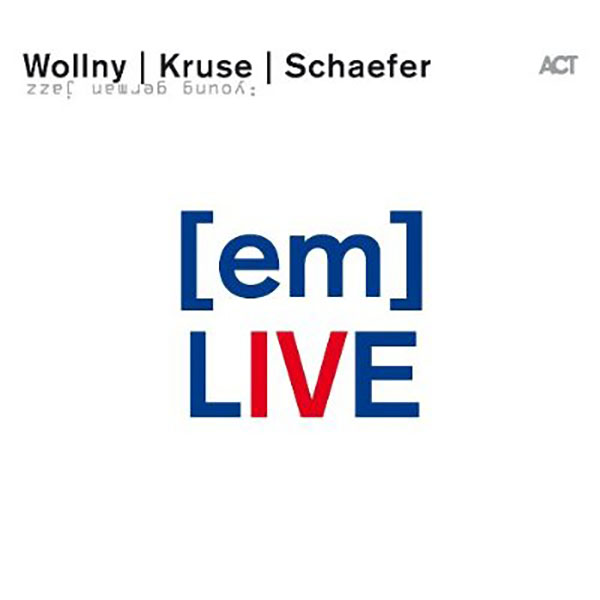
by Ian Mann
October 18, 2010
/ ALBUM
This album should help to cement the trio's reputation as one of the most interesting and exciting acts in European jazz.
{em}
“Live”
(ACT Music ACT 9668-2)
It’s been over two years since the release of {em}‘s last studio album so the appearance of this concert recording documenting the trio’s appearance at the 2010 JazzBaltica Festival in Salzau is most welcome. The long running line-up of Eva Kruse (bass), Eric Schaefer (drums) and Michael Wollny (piano) remains in place and although all three members are also heavily involved in numerous other projects there is a palpable sense of a real musical chemistry when the three perform together.
Following three studio albums this is the first time that the live incarnation of {em} has been captured on record. The group’s previous album “{em}3” concentrated on the lyrical side of the band in a series of exquisite miniatures but “Live” finds them returning to the more groove orientated approach that characterised their earlier records and made them such a popular act in the first place. The group’s artistic and commercial success in their native Germany invited comparisons with ACT stable mates E.S.T. and {em} remain one of ACT supremo Siggi Loch’s most inspired and significant signings.
The JazzBaltica performance came about due to the invitation extended to pianist Michael Wollny to fulfil the role of “Artist in Residence” at the festival. However it’s drummer Eric Schaefer who features as the composer of six of the ten tunes on an album offering an enticing blend of four old favourites and six new compositions. Most of the pieces are relatively short with the emphasis on grooves and rhythms and the six new items had already work-shopped by the trio at Schloss Elmau, ACT’s “country retreat”, in late 2009.
The album opens with “Bluten” , a new composition from the pen of Schaefer that successfully combines the two strands of rhythm and melody as the three instrumentalists mesh together with Kruse’s bass playing a central part in the proceedings.
Kruse is also prominent in the early stages of Schaefer’s “Shelley” adding rich arco textures and taking a lyrical pizzicato solo before Wollny’s piano takes flight in the super percussive style of Neil Cowley. Schaefer and Kruse add pounding, rock influenced rhythmic accompaniment before a more subdued resolution.
There’s a similar urgency about Schaefer’s “Phlegma Phighter”, a tune that originally appeared on “{em2}”. Frantic groove based passages alternate with more lyrical moments and almost free jazz episodes. The restlessly inventive {em} rarely remain in one place for long. This is a bravura performance that receives an enthusiastic response from the Salzau crowd.
“Sov Lilla Alma” is Kruse’s dedication to her young daughter-Kruse’s maternity leave is one of the reasons we haven’t heard from the group for so long. By {em} standards Kruse has deliberately kept the piece relatively simple in a successful attempt to develop an E.S.T. style groove.
Wollny’s “Kiyoshi” appeared on the band’s most recent studio album and is a homage to the Japanese horror film director Kiyoshi Kurosawa. Wollny has a love of horror and the Gothic as evidenced by his brooding solo piano album “Hexentanz”. Opening with eerie arco bass and with the mood resolutely dark and foreboding this is classic Wollny as doomy, atmospheric piano chords mingle with sinister, rustling percussion.
Following the baleful soundtrack of “Kiyoshi” the groove based energy of Kruse’s “In Water” almost comes as light relief. Again it’s an attempt to move the band closer to E.S.T./Neil Cowley territory although it’s possible that {em} have never heard of the latter. Kruse is featured as a soloist between bouts of rock influenced grooving.
“Etude No. 1” is a good deal more forceful than the somewhat academic sounding title might suggest. The tune begins with stadium rock style drumming and there’s some joyous piano as Wollny reveals his lighter side.
Instead it’s “Arsene Somnambule” from “{em}3” that provides some of the album’s most thoughtful and impressionistic moments in a delicate exploration of the hinterland between structure and freedom.
From “{em}2” Schaefer’s “Gorilla Biscuits”, his tribute to the rock band of the same name, also flirts with free playing before the trio dive off into hard grooving, rock influenced territory with Kruse and Schaefer’s relentless rhythms fuelling some brilliantly virtuosic playing from Wollny. This is a high octane performance that brings roars of approval from the JazzBaltica crowd.
The trio nearly match those energy levels on the closing “Break It”, another foray by Kruse into almost rock based territory. There’s a sense of humour too, something which permeates much of the album and acts as a welcome balance to Wollny’s more Gothic leanings.
“{em} Live” sees the trio continuing to experiment with their sound and reveals the energy levels the trio are capable of reaching in concert . The album has an immediate, almost visceral appeal not commonly associated with the contemporary piano trio. Fans of E.S.T., the Neil Cowley Trio and The Bad Plus should find much to enjoy here but {em} are also very different from any of those bands. They bring something unmistakably German to their music making, and no, it doesn’t lack a sense of humour.
Everything is admirably concise, there’s no flab on “{em} Live”, and the playing itself from all three participants is little short of brilliant. This album should help to cement the trio’s reputation as one of the most interesting and exciting acts in European jazz. Let’s hope they can be persuaded to make some UK appearances outside of London in 2010/11.
blog comments powered by Disqus